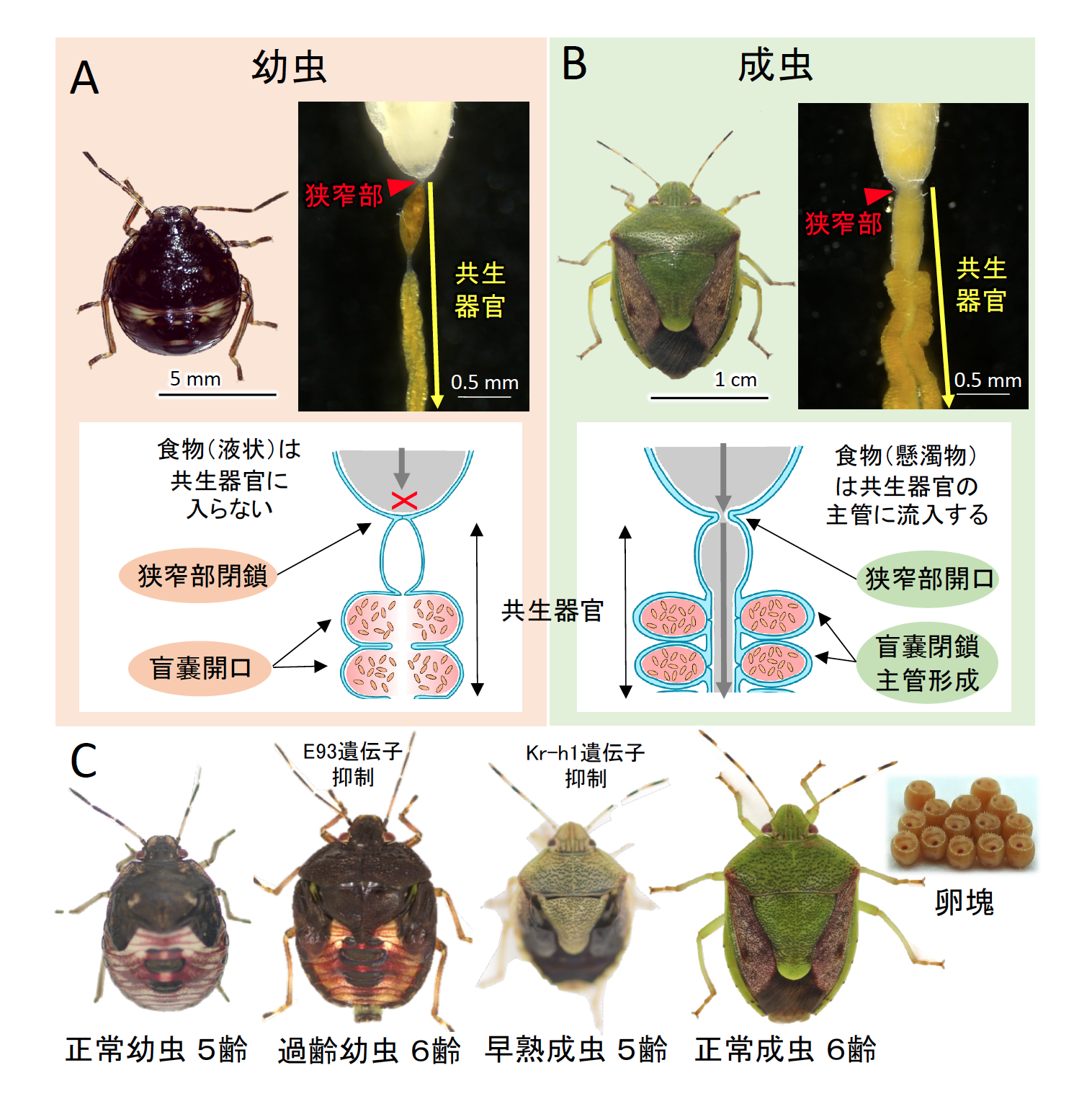Disclaimer: machine translated by DeepL which may contain errors.
Symbiotic organs and symbiotic bacteria regulated in insect metamorphosis.
Sayumi Oishi (Graduate student, Department of Biological Sciences, at the time of research)
Takema Fukatsu (Chief Scientist, National Institute of Advanced Industrial Science and Technology (AIST) / Professor, Department of Biological Sciences (adjunct))
Insect metamorphosis is dramatic. Insect metamorphosis is dramatic: their morphology changes dramatically, and their survival principle shifts from growth to reproduction.
The symbiosis between insects and microorganisms is universal.
Inside specialized cells and digestive tracts, microorganisms essential for survival reside, adapting to foods and environments that are difficult for them to access alone.
How are these symbiotic relationships regulated during metamorphosis?
We found that during stink bug metamorphosis, not only the structure of the insect's own symbiotic organs
but also the function of symbiotic bacteria switches from supporting growth in larvae to promoting
reproduction in adults.
The endocrine regulation of insects extends to the microorganisms in their bodies,
revealing part of a highly integrated symbiotic mechanism.
![]()
Many insects have close symbiotic relationships with microorganisms. For example, stink bugs live by sucking plant juices with their needle-like mouthparts, and the supply of essential amino acids and vitamins by symbiotic bacteria is essential for their growth and survival. The brown stink bug has a symbiont organ consisting of an array of sac-like blind sacs at the posterior end of its digestive tract, which harbor symbiotic bacteria in their lumen. Oddly enough, the structure of the gastrointestinal tract, including the symbiotic organ, differs between larvae and adults. In larvae, the anterior end of the symbiont is closed, and food does not enter the symbiont, but is digested and absorbed entirely in the anterior half of the digestive tract (Figure A). This is apparently possible because the larvae are suckers. The second half of the gastrointestinal tract, therefore, does not allow food to flow and is dedicated to the possession of symbiotic bacteria. In adults, on the other hand, the anterior end of the symbiont opens, allowing food to flow into the posterior half of the gastrointestinal tract, where it can digest and absorb larger amounts of food (Figure B). Why and how do these changes occur? Since these changes occur during the process of larval development to adulthood, we expected that they might be related to metamorphosis.
In insects, metamorphosis from larva to adult occurs by changing the expression of metamorphosis-regulated genes under the action of juvenile and molt hormones. When the expression of the adult-forming gene E93 was suppressed in fifth instar larvae before hatching, they became sixth instar overgrown larvae that maintained their larval form even after molting (Figure C). On the other hand, when the expression of the larvalization gene Kr-h1 was suppressed in fourth instar larvae, they became precocious fifth instar adults after molting (Figure C). When the symbiotic organs of these larvae were examined, the symbiotic organs of the overgrown larvae were larval-type even though they were 6th instar, and the symbiotic organs of the precocious adults were adult-type even though they were 5th instar. These symbionts were found to have adult-type symbiotic organs even though they were in the fifth instar.
Gene expression and metabolism of the symbionts revealed that they synthesize cysteine, a type of amino acid, in particularly high amounts.
The brown recluse is known as a prolific agricultural pest, laying approximately 14 eggs every 2 to 3 days for more than a month under suitable rearing conditions (Figure C). Eggs are encased in a robust eggshell, and investigations have revealed that cysteine accounts for more than 10% of the amino acid composition of the eggshell, indicating that a large amount of cysteine is required for egg production.
 Metamorphosis and symbiotic organs of the chabanaeid beetle. (A) Conidiophores of larvae. (B) Conidiogenous organ of an adult. (C) Normal larva, over-aged larva, precocious adult, normal adult, egg mass.
Metamorphosis and symbiotic organs of the chabanaeid beetle. (A) Conidiophores of larvae. (B) Conidiogenous organ of an adult. (C) Normal larva, over-aged larva, precocious adult, normal adult, egg mass.
Interestingly, the symbiotic bacteria in the adult-type symbiotic organ produced high levels of cysteine even in the fifth instar precocious adult induced by manipulation of the metamorphosis control gene. This indicates that the physiological function of symbiotic bacteria is under the control of host insect metamorphosis.
This research result elucidates one aspect of the highly integrated symbiosis mechanism in which symbiotic bacteria in the body of a heterologous organism are subjected to endocrine control by the host insect.
This study was published in S. Oishi et al. PNAS, 120, e2304879120 (2023).
(Press release, September 26, 2023)
Published in The Rigaku-bu News, January 2024.
Frontiers of Science for Undergraduates


